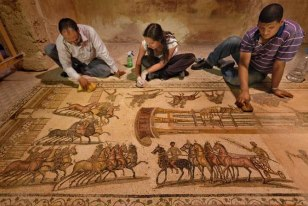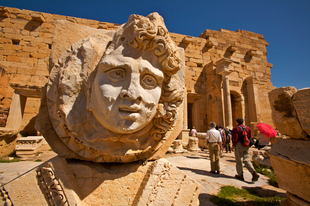- Trayendo el pasado de Libia en el siglo XXI
- 11.02.13
Un grupo de arqueólogos internacionales superiores y profesionales del patrimonio están en Trípoli para una serie de talleres sobre cómo proteger y preservar los cinco sitios de Patrimonio Mundial UNESCO y numerosos restos arqueológicos que son sinónimos del país.
Es importante que Libia ahora desarrolla un marco para promover, proteger y administrar su patrimonio. Sin embargo, éstos necesitan no llevará a cabo en el gobierno a niveles locales, solas comunidades también deben ser alentadas a cuidar de su propia cultura.
La visita de cuatro días reunió a un número de seleccionados profesionales dispuestos a intercambiar conocimientos y ideas sobre el camino hacia adelante para proteger y digitalización de la historia y la cultura Libia. Patrimonio del país ha sufrido sólo daños limitados durante la revolución, sin embargo, Libia ha recientemente también fue testigo, "las excavaciones clandestinas" en Algalaa de la posguerra y um Shuga, donde personas han utilizado máquinas industriales en busca de oro era Gadafi.
- Starting in June, the programme, which was set up by the Polish Economy Ministry, is geared at enabling Polish experts to export their services and products to new markets. It also promises to create business opportunities and allow professionals to exchange knowledge and skills.
“One of the aims of the programme is to have Polish specialists take care of Libyan monuments, by offering economic solutions and a high quality service,” Siwek said. Polish archaeologists already have a presence in the country. Teams from one of Poland’s top academic institutions – Warsaw University – have worked on the site of Ptolemais since 2001. Through extensive topographical studies, they produced the first detailed plan of the city, one of the ancient capitals of Cyrenaica. Siwek said that modern technological developments had increased the team’s ability to make archaeological surveys, using geophysics and computer graphics. The map of Ptolemais, she said, not only filled in previous gaps, but also added a new level of topographical antiquity.
- Since 2005, geophysical research, including geo-electrical and magnetic measurements, has been carried out. The work of Polish archeologists at Ptolemais has so far covered an area of some 18 hectares, both inside and outside the city walls. “Their major achievement,” Siwek said, “was the development of methodologies for measuring and determining the best possible types of geophysical equipment for use with the remnants of architecture.” Using such modern technology, a Polish team is currently working on a virtual reconstruction of the ancient temple of the pharaoh Totomes III in Egypt.
“The Polish technical and conservation abilities are appreciated and respected all over the world,” Siwek said. Poland’s input in this area could be timely. Last week in Tripoli there was a meeting of top archaeological experts from around the world, to discuss how Libya could preserve its valuable heritage. The focus of the four-day event was on how to record sites and treasures with modern techniques, and how best to protect and preserve the country’s many sites, which range from pre-historic rock-art in the Sahara to ancient Greek and Roman ruins along the coast.
(Source: Libya Herald)




